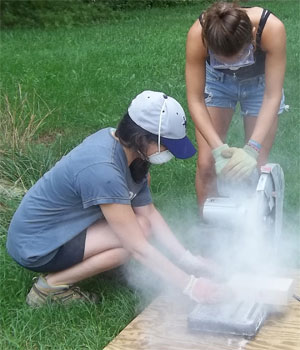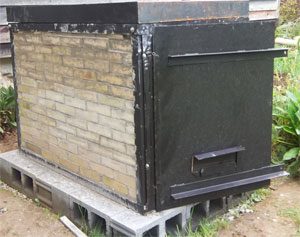Cutting Edge Heating System Tested at Rockingham Farm
News
By Eric Gorton and James Hong ('14), JMU Public Affairs
|
Related Links |
A Rockingham County farm could be heating a greenhouse and getting an environmentally friendly fertilizer supplement from the same system by early 2012.
Four JMU seniors have completed construction on a system that will produce heat while creating biochar, a soil supplement that is gaining attention around the world for its potential to boost crop yields.
"The farmer is going to benefit even if the biochar doesn't give them as big a boost as we hope," said Dr. Wayne Teel, associate professor of integrated science and technology and the advisor of the student project. "We know for sure it can provide heat."
Biochar is a type of charcoal made by burning waste wood, grass and other cellulosic materials in low oxygen. The waste materials are burned inside a chamber, which can be as simple as a metal drum, that is placed inside a larger chamber. Wood chips are burned in the outer chamber to heat the material in the inner chamber. When the inner chamber heats to about 650 degrees Fahrenheit, the materials begin to smolder and give off gasses. The gasses they give off are vented to the outer chamber and used to fuel the external fire until the process is complete. The excess heat from the process, in this case, is being used to heat the greenhouse.
Marlee NajamyWinnick, one of the four students working on the project, said the system heated the greenhouse during the first test on Dec. 10. The students will work on improving its efficiency for the next test, she said.
Teel has been researching biochar and pyrolysis, the burning process used to make biochar, since 2007. His students produced their first batch of biochar during the 2009-2010 school year.
The four students working on the project now, all females, have built the system at Avalon Acres farm in Broadway from the ground up. They started building the unit in August with funding from Valley 25 by '25, an organization that promotes using a diverse energy portfolio to achieve 25 percent renewable energy in the Shenandoah Valley before 2025.
"I've never done such a hands on project in college," said Dee Spolarics, another team member. "The project evolved into encompassing many different aspects such as the environment, energy and sustainability, which all interests me. I really like being able to see the results of all our hard work in an applicable system."
Added Amanda Martindale, "Coming into college as an ISAT major, I was hoping to get some hands on experience, but wasn't expecting something this involved. It has been a great learning experience for all of us. It's wonderful to work with an enthusiastic professor and professionals in the construction/plumbing field, and to know that we have built a renewable energy system." The pyrolysis unit will serve as a compliment to the primary heat system, which is solar. Both systems heat water that then heats the greenhouse.
The project entails much more than building the pyrolysis unit. Students also have been involved in testing the characteristics of biochar to determine acidity levels, density and other properties. They are also conducting experiments to see if, or how well, biochar assists plant growth. Studies in other parts of the country and the world have been promising.
Biochar seems to work best if mixed with manure, compost or another fertilizer, Teel said. Biochar captures nutrients that would otherwise leach out of the soil and holds them in place for the plant roots. Most of the JMU tests have been conducted in greenhouses on campus.
"We need to do field experiments," Teel said. He hopes to partner with some small farms in the area that are willing to use biochar on their fields and monitor the effect. "They are in their fields every day and can make the observations we need on a regular basis, intelligently, because they know their crops well," said Teel.
If initial results are positive, Teel said he could expand the research and the number of partner farms. The four students involved also want to research if biochar can be made from the byproducts of biodiesel production using algae.


